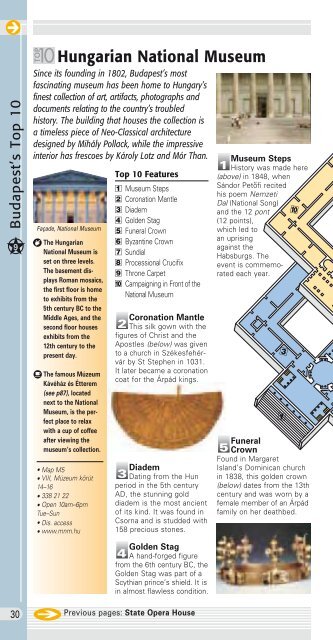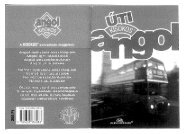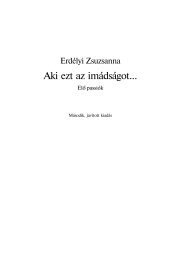You also want an ePaper? Increase the reach of your titles
YUMPU automatically turns print PDFs into web optimized ePapers that Google loves.
Budapest’s Top 10<br />
30<br />
Hungarian National Museum<br />
Since its founding in 1802, Budapest’s most<br />
fascinating museum has been home to Hungary’s<br />
finest collection of art, artifacts, photographs and<br />
documents relating to the country’s troubled<br />
history. The building that houses the collection is<br />
a timeless piece of Neo-Classical architecture<br />
designed by Mihály Pollack, while the impressive<br />
interior has frescoes by Károly Lotz and Mór Than.<br />
Façade, National Museum<br />
The Hungarian<br />
National Museum is<br />
set on three levels.<br />
The basement displays<br />
Roman mosaics,<br />
the first floor is home<br />
to exhibits from the<br />
5th century BC to the<br />
Middle Ages, and the<br />
second floor houses<br />
exhibits from the<br />
12th century to the<br />
present day.<br />
The famous Múzeum<br />
Kávéház és Étterem<br />
(see p87), located<br />
next to the National<br />
Museum, is the perfect<br />
place to relax<br />
with a cup of coffee<br />
after viewing the<br />
museum’s collection.<br />
• Map M5<br />
• VIII, Múzeum körút<br />
14–16<br />
• 338 21 22<br />
• Open 10am–6pm<br />
Tue–Sun<br />
• Dis. access<br />
• www.mnm.hu<br />
Top 10 Features<br />
1 Museum Steps<br />
2 Coronation Mantle<br />
3 Diadem<br />
4 Golden Stag<br />
5 Funeral Crown<br />
6 Byzantine Crown<br />
7 Sundial<br />
8 Processional Crucifix<br />
9 Throne Carpet<br />
0 Campaigning in Front of the<br />
National Museum<br />
Coronation Mantle<br />
This silk gown with the<br />
figures of Christ and the<br />
Apostles (below) was given<br />
to a church in Székesfehérvár<br />
by St Stephen in 1031.<br />
It later became a coronation<br />
coat for the Árpád kings.<br />
Diadem<br />
Dating from the Hun<br />
period in the 5th century<br />
AD, the stunning gold<br />
diadem is the most ancient<br />
of its kind. It was found in<br />
Csorna and is studded with<br />
158 precious stones.<br />
Golden Stag<br />
A hand-forged figure<br />
from the 6th century BC, the<br />
Golden Stag was part of a<br />
Scythian prince’s shield. It is<br />
in almost flawless condition.<br />
Previous pages: State Opera House<br />
Museum Steps<br />
History was made here<br />
(above) in 1848, when<br />
Sándor Petπfi recited<br />
his poem Nemzeti<br />
Dal (National Song)<br />
and the 12 pont<br />
(12 points),<br />
which led to<br />
an uprising<br />
against the<br />
Habsburgs. The<br />
event is commemorated<br />
each year.<br />
3<br />
1<br />
0<br />
Funeral<br />
Crown<br />
Found in Margaret<br />
Island’s Dominican church<br />
in 1838, this golden crown<br />
(below) dates from the 13th<br />
century and was worn by a<br />
female member of an Árpád<br />
family on her deathbed.











